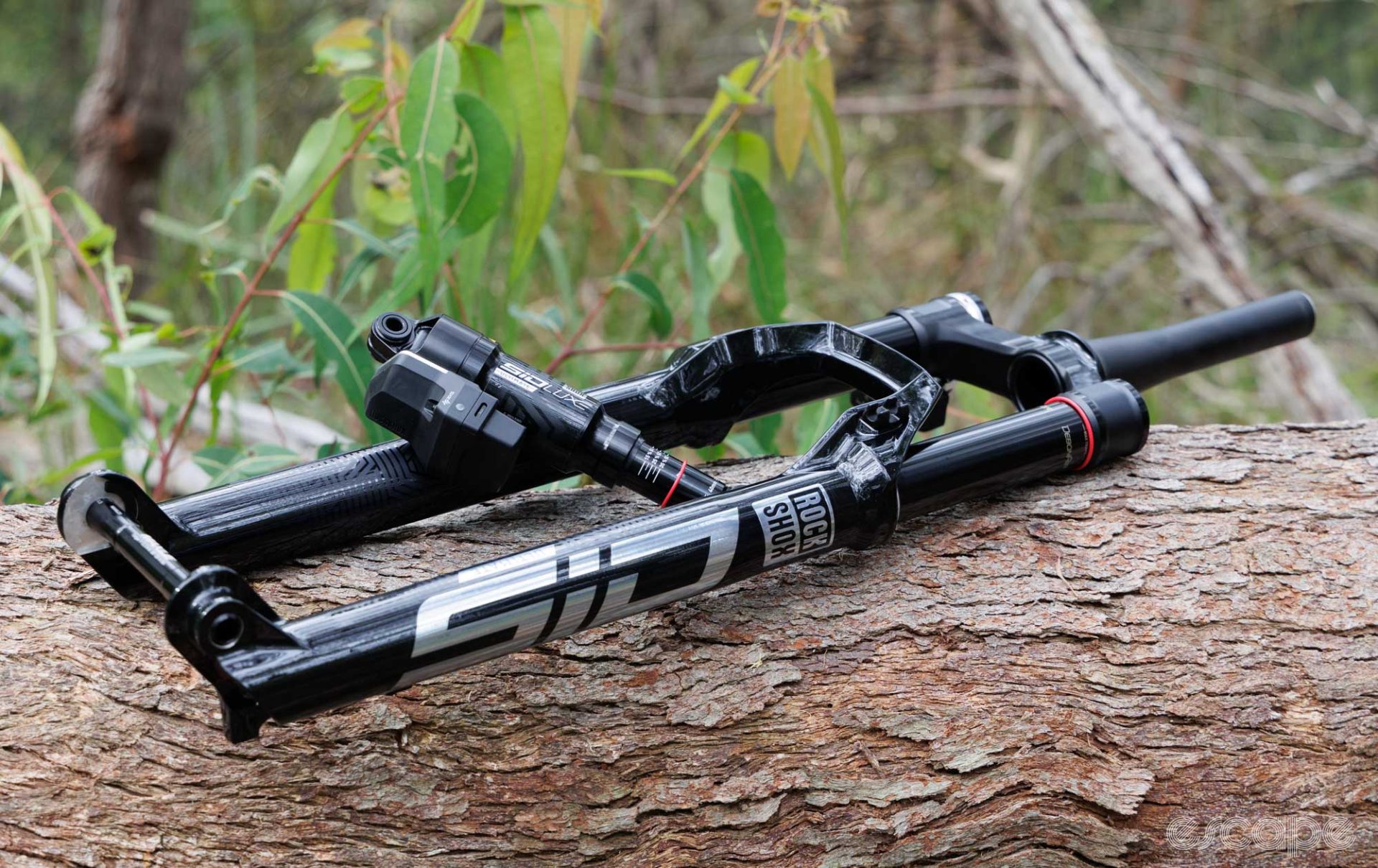It’s been a long time coming, but RockShox’s electronically controlled suspension is finally available to cross-country whippets. Indeed, the news won’t come as a surprise to anyone familiar with the SRAM-owned company’s longer-travel product offerings or those who followed the 2023 World Cup season, during which Nino Schurter won his record 34th World Cup on the stuff. Still, the flashy suspension is now available to buy, and yes, I’ve ridden it.
With this release, you can expect a tsunami of new cross-country bike releases or at least an expansion of premium model options. I’ve been testing the new electronic system on the new Yeti ASR, and you can bet we’ll see many others.
The short of it: RockShox’s answer to electronically controlled suspension comes to the cross-country world in a fully wireless system that now integrates metrics from a power meter for automated control.
Good stuff: It turns any mediocre-pedalling bike into a weapon without needing another remote to push, an impressively hands-free and care-free riding experience, manual mode is superior to a cabled lockout, SRAM’s app and connectivity are an industry benchmark.
Bad stuff: Batteries to charge, an added cost, zzztt-zzztt all the time, a minor weight penalty, the auto setting is not always perfect, and there is little for mechanics to do other than replace in the event of a problem.
Price: From US$1,349 / Є1,499 / £1,339 within a fork, and US$849 / £949 / £849 in a rear shock. Extras may be required, or an existing 2024 fork could be upgraded.
Flight Attendant, an intro
The dynamic nature of mountain bikes means engineers have always fought between keeping suspension active for bump absorption and traction, while trying to make it less active not to waste energy in pedalling. There are many paths to the age-old problem, and over the past 25 years, electronically controlled suspension has been one such solution. First, It was K2 with its automatic Smart Shock (1997!); later we saw Cannondale use electronics to make manually locking out the suspension easier and quicker; in more recent years, we’ve seen electronically wired automatic suspension from both Fox (LiveValve) and RockShox (E.I, in conjunction with Lapierre).
Flight Attendant is RockShox’s present-day answer to the electronically controlled suspension on full-suspension bikes (fork and rear shock). First released in 2021 for longer-travel trail and enduro bikes, it’s part of SRAM’s broader AXS wireless product group and is powered by the same batteries that make SRAM’s electric derailleurs and dropper posts go zzppp-zzppp.

Flight Attendant is designed to automate the control of the suspension low-speed damping. Instead of making the rider manually pull a cable or twist a dial to change the suspension between its open, pedal (aka, a bit firmer), and/or lock settings, Flight Attendant electronically controls the three stages of firmness based on what the terrain and rider are doing. Optionally, the user can also take over said control, giving a manual but wirelessly controlled suspension lockout at the push of a button.
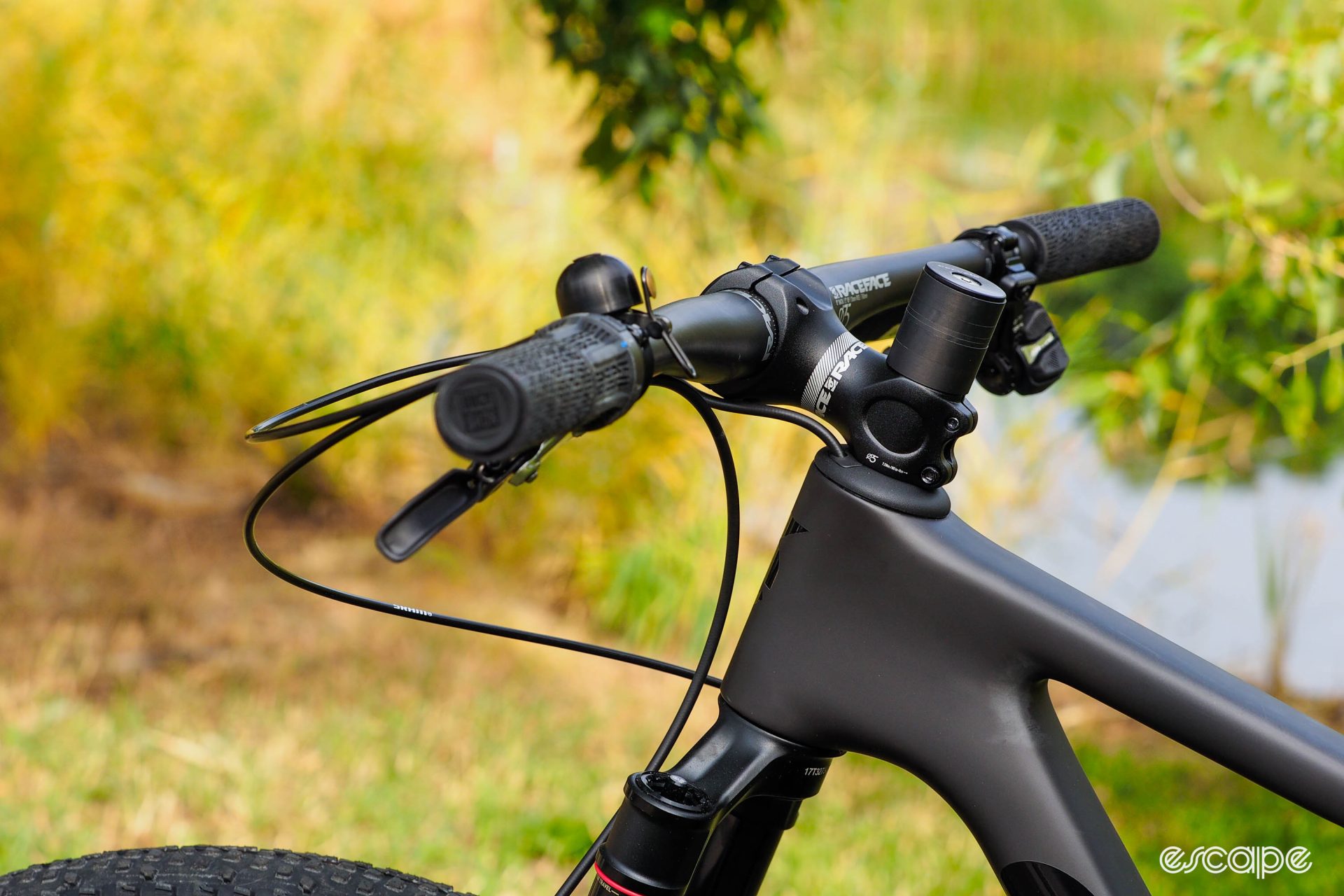
In its original form, it’s assumed (but not confirmed by the company) that Flight Attendant used impacts, incline, and cadence (from a pedal sensor or power meter) to decide which damper setting was best. Now, with this new release, and only when combined with an SRAM/Quarq powermeter, Flight Attendant has increased the system capability with what SRAM is calling “Adaptive Ride Dynamics.”
Instead of simply using cadence to know when you’re pedalling, Flight Attendant can now be set to continually analyse your power output, set power zones (and adapt them over time), and use that as further data for deciding which compression setting is right for the moment. There’s no AI here, but rather an algorithm bases the suspension setting with power zones as a further input metric. Low power efforts are treated to more open suspension, while efforts well beyond your average typically cause the suspension to firm up or lockout.

SRAM is tight-lipped over what exactly is informing Flight Attendant in doing what it does. “The competitive landscape around Flight Attendant is challenging, and the developments are fast-paced. Because of this we are not providing specific information around what data we are using,” answered Chris Mandell from SRAM’s mountain bike division.
Clearly, when power data is available, it’s a key metric. Forces and impacts at the wheel are clearly another metric. And incline seems to be another. SRAM has even teased that syncing the system to an AXS drivetrain may be a further factor. However, they have ruled out a Reverb AXS dropper seatpost being a factor, as this product “only knows if the valve is open or closed, it does not know what position it is in.”
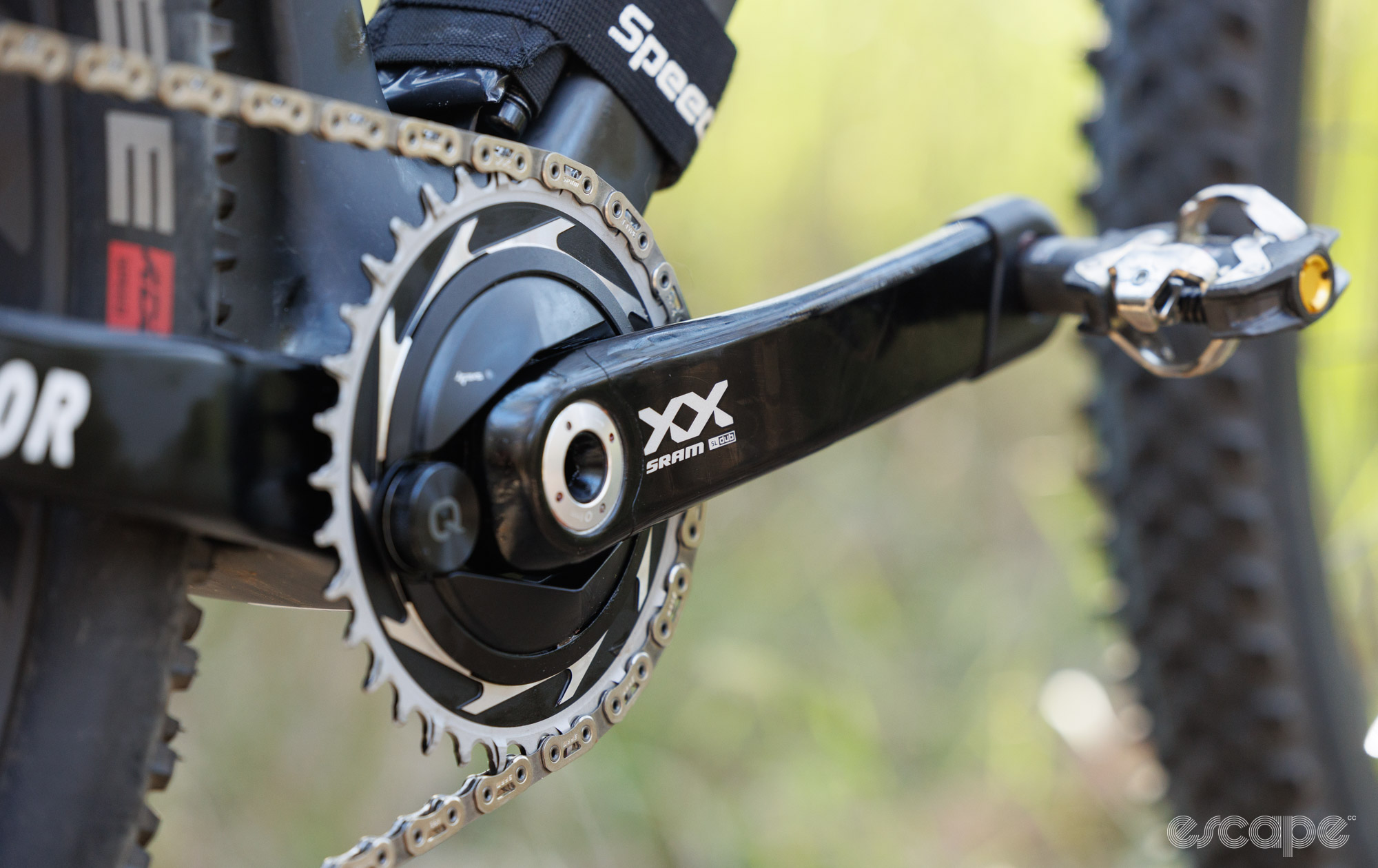
Whatever it’s using, according to SRAM the system analyses the situation every 5 milliseconds (that’s even more frequent than my thinking of tools) and adjusts accordingly. To put that into perspective, the system on Nino Schurter’s bike is said to have made 1,395 automatic suspension changes during the 90-minute race – on average one every four seconds, although the distribution was very likely quite different – that saw him nab that 34th World Cup victory. Yeah, that’s enough to give anyone trying to replicate it with a cable-operated system a repetitive stress injury.
And that brings us to the benefit in cross-country racing – having one less thing to think about. Usually, there’s the chaos of focusing on your trail line, body position, effort, competitors, gear selection, dropper post position, and suspension. For me, I’ve always preferred set-and-forgot full suspension bikes with suspension that pedals efficiently rather than relying on a lockout. By contrast, Flight Attendant effectively makes this a moot point, and turns every bike into one that’s more set-and-forget. Furthermore, and unlike twin-cable-operated systems, Flight Attendant can split the settings of the front fork and rear shock – making the rear shock firmer than the fork when it deems it appropriate.
Inside the Flight Manual
Flight Attendant is currently only available on RockShox’s premium-level Ultimate suspension products and can only be used on a full-suspension bike. Yep, it’s not an option for hardtail riders at this time.
For the fork, Flight Attendant is isolated to the damper-side (right) leg, where it merely controls the low-speed compression circuit (aka, the lockout). The air spring and rebound settings are wholly independent from the system and are tuned separately like any other suspension. As Flight Attendant is not connected to the air spring it cannot assist with suspension setup like a Quarq ShockWiz.
The new Flight Attendant is available only on the 2024 SID (35 mm stanchion) and SID SL (32 mm stanchion) forks, and can be added aftermarket to these new forks (look for the milled aluminium crown) with a change to the Flight Attendant module and matching Charger Race Day 2 damper. A pre-existing SIDLuxe rear shock cannot be upgraded, and you’ll need a whole new rear shock to complete the system. Earlier gravity-type Flight Attendant forks and shocks can be updated with new firmware, however, for “improved performance.”
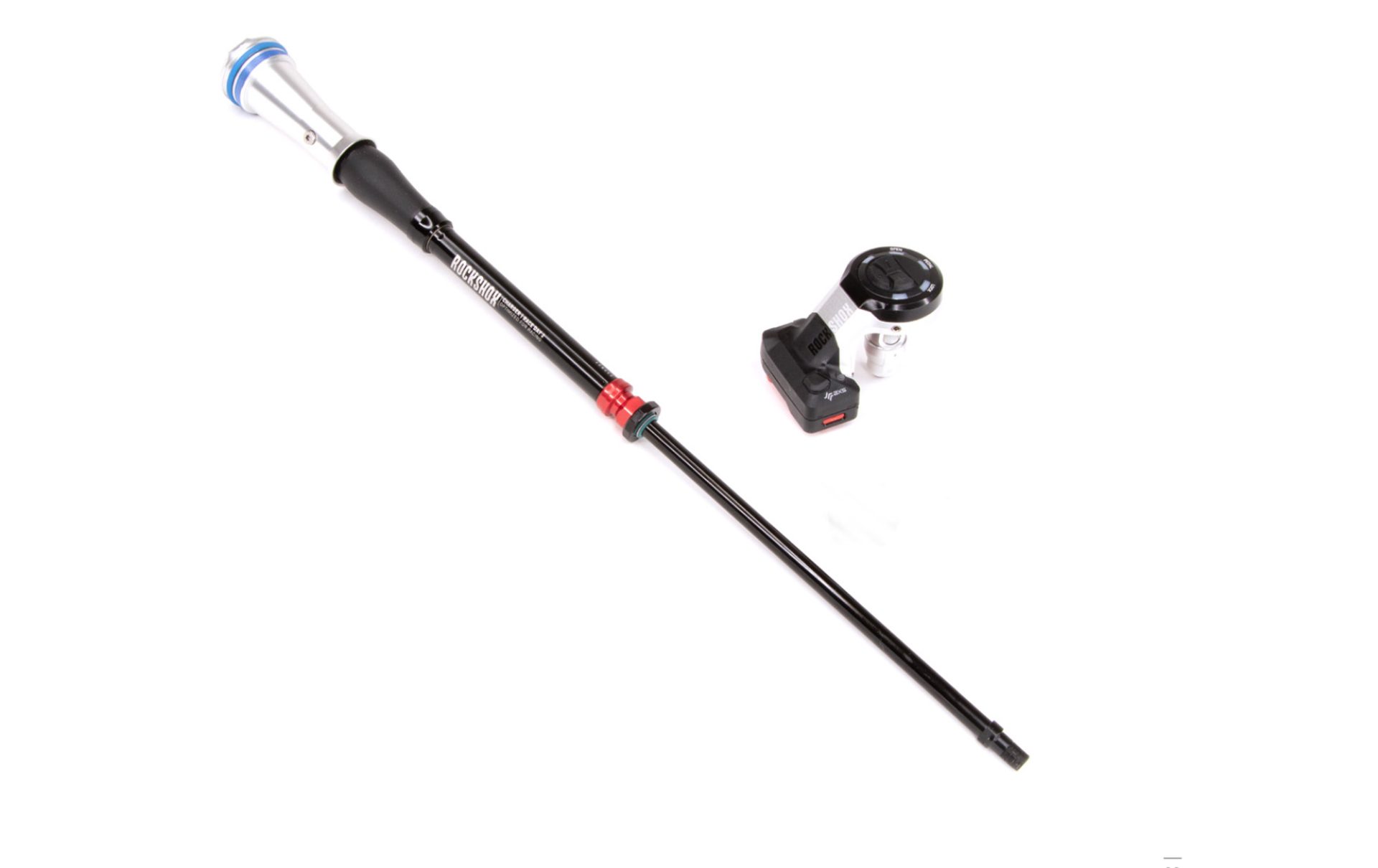
Can you add Flight Attendant to your existing bike? Well, maybe. RockShox warns that some bikes may not have the clearance for the rear shock module and suggests sticking with frames approved at an OE level. That said, there are plenty of pre-existing bikes on the market that should present no issues in receiving such an upgrade.
In the cross-country world, pre-existing bikes on the approved list include the Specialized Epic Evo (2020-23), Santa Cruz Blur and Blur LT (2022+), Pivot Mach 4 SL Gen 3 (2023+), Orbed Oiz and Oiz TR (2020-2023), Canyon Lux Trail and Lux World Cup (2023+), and Mondraker F Podium (2023+).
Pricing-wise, expect to pay US$1,349 / Є1,499 / £1,339 for the 32 mm stanchion SID SL with Flight Attendant. The longer travel and thicker stanchion SID Ultimate version sells for US$1449 / £1,599 / £1,429. Meanwhile, the SIDLuxe rear shock is US$849 / £949 / £849 with hardware. You’ll also need a pedal sensor or Quarq power meter (spindle or spider-based). Meanwhile, using a control shifter (which can be shared with an AXS Reverb post, as my test sample was) is optional.
Weight-wise, SRAM claims the Flight Attendant system adds about 220 grams, but I don’t believe that is a wholly apples-to-apples comparison. If you assume the use of a Quarq powermeter and an AXS remote for a dropper for either setup, then the weight gain is realistically closer to 100 grams if compared against the nearest comparable option of having a dual remote cable lockout, cables, housing, and all.
More specifically, my tested SIDLuxe rear shock in a 190×40 size, and including the battery and mounting hardware, weighed 358 g. Meanwhile, the SID Ultimate fork at 120 mm travel, including battery and a lightweight Cane Creek starnut (axle excluded, steerer cut to 171mm) is 1,580 g actual. By comparison, a standard SIDLux rear shock without cable/remote is claimed to weigh 246 g, with the SID Ultimate fork quoted at 1,476 g (again, without remote and cables).

All the electronics pass IPX7 water-resistant certifications, meaning they’ll be fine with everything you’d experience on a ride. Just don’t go trying to pressure wash the logos off them.
Battery-wise, RockShox claims 20-30 hours of ride time between charges, but those figures can vary greatly. Like electric shifting or droppers, the battery life will vary based on exact usage, how much you fettle with the bike, drive your bike around with the batteries installed, and what features are in use. If you forget to charge the system, a flat battery will revert the system to its open setting.
In Flight
Getting going with Flight Attendant is all impressively easy, familiar, and smooth sailing. Installing it is hardly different to a regular fork and shock and infinitely easier than cabling up traditional lockouts. With the suspension set manually into open mode, you set the air pressure (sag) and rebound up like you would with any other suspension. From there, you go through a simple and quick calibration that involves first keeping the bike straight and level, before then tilting the system left. And that’s it, you’re ready to ride.
Connecting the suspension to the SRAM AXS phone app offers a handful of useful features, namely, you have an easy way to track the batteries, update firmware, and be walked through calibration. The app is also how you would adjust system bias, which is the ability to tell Flight Attendant whether you want it to sway on the side of softer or stiffer setting when in its automatic mode. For my rocky trails I found it pretty great in the stock bias mode, and would even err on the side of a more open bias setting if not racing. Of course, what bias setting is right for you will wholly depend on your style of riding, local terrain, upper body strength, and even bike design – either way, it’s great to have this setting control, and I like that SRAM hasn’t overcomplicated it.

The app also allows adjustment of the Low Speed Compression (LSC) on the more gravity-oriented Flight Attendant models. Given the simpler damper, this feature is unavailable within the SID range.
You can run Flight Attendant without a handlebar-mounted controller. However, I used SRAM’s two-button pod controller, with the lower button controlling an AXS dropper and the upper offering the option for manual suspension control. I found myself mostly leaving the suspension on its automatic mode and trusting it to do the right thing, but even in this setting, the controller does give the option to force the auto-mode into a locked state if you desire. Note that such control isn’t currently available for SRAM’s wireless blips.

I’ve already made this joke, but this is literally flashy suspension. Look at the system on the right fork crown, and you’ll see a series of different colour flashing lights that tell you different things. While riding with a synced Quarq power meter, those lights can be used to display your power zone which is a clever feature for anyone who may want to monitor effort levels without using a head unit. I found them more distracting than beneficial, and once again, the app can be used to turn off the disco.
I could make this an incredibly long review about the finer points of the SID suspension, the way the damping still feels a little on the stiff side over lightly choppy terrain, that the recommended air pressure settings for the fork are on the high side, or how the 2024 fork construction improves on the old. However, I won’t. There are many reviews already covered the previously released 2024 updates to the SID lineup, and so I’ll leave you to search for those if you choose. Rather, let me focus on what you’re here for: Flight Attendant.
Without knowing exactly what data input it uses to do its thing, I will say that I’m impressed with how it functions. It truly is an eye-opening experience to be on a bike running 30% sag in the rear end, and be able to go from out of the saddle sprints to rocky descents without ever having to tell the suspension what to do. In this way, it’s not unlike Specialized’s Brain system of the past, just better in every regard. The system eagerly seeks to be in open mode, and the slightest bump, compression, or preload will put it there, but it does a remarkable job of stiffening up the bike exactly when you want it to.

Ok, so it’s great, but not perfect. On rare occasions, I found the system in a setting that I didn’t deem ideal, however, it would quickly get itself out of that mode before I had a chance to add to the swear jar. One example is when doing a short burst of power up a minor incline with some sort of technical feature or square edge, the suspension would react to the high power input and incline with a stiffer setting, but in some instances that setting would give me less traction than I was seeking for that initial impact. Hitting the object would then open up the suspension, which may or may not be what I wanted in that moment. A more open bias setting would correct it, but I’m sure riders used to an old Specialized Epic with Brain suspension would equally argue the stiffer suspension is exactly what they want under such brief bursts of effort.
On the flip side, there were moments where it kept the suspension open for a split second longer than I ideally wanted. This occurred when going from a steep descent straight into an uphill sprint. It would quickly catch on, but it certainly took a few rides to build trust in it. This is one area where adjusting the bias to a firmer setting helps, which then increases the previous trade-off.
Further quirks in the system are noticed if riding along a perfectly smooth surface and then suddenly requiring the suspension to move, such as if hitting a pothole on the road, trying to bunny hop a curb, or merely diving into a single track on the side of the road. Here, the Flight Attendant often gives an initial jolt, once again, extremely similar to the old Specialized Brain technology, just better mannered with less fatiguing. Those better mannerisms clearly come from the Flight Attendant being incredibly sensitive, with even the rumble of a passing truck along smooth tarmac enough to open up the suspension. With time, you learn that pushing on the suspension a second before you need it preps it for what’s coming up, but no doubt, there’s a learning curve to that.
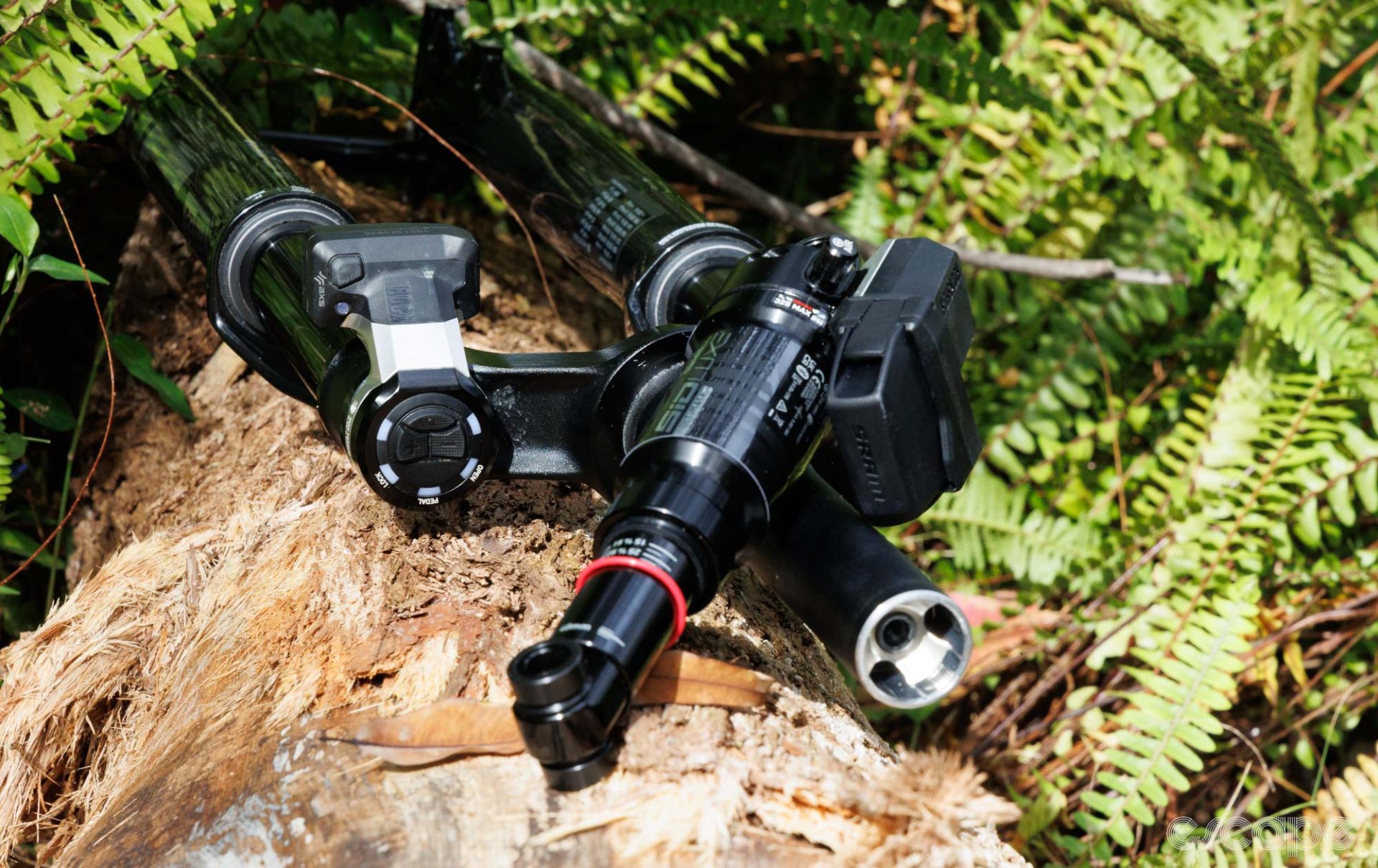
This occasional inconsistency isn’t ideal when just playing around on trails, but it’s a trade-off I’ll happily take when racing. For those that can’t come to terms with it, then there’s always the manual mode which remains a superior option to a cable-operated lockout system. This may seem trivial, but having a short press of a light action button is a huge energy and time saver versus any cable-operated system – it’s the same argument for why SRAM’s AXS seatpost is often regarded as the nicest functioning dropper available (something I believe to be true).
I also have a small nit to pick concerning the rather ugly module hanging off the fork crown. While it didn’t happen in testing, prior experience tells me that your knee can contact something in this position. Thankfully the edges are smooth, but one day I’m sure the rear wheel will break traction at the wrong moment and I’ll be AXSing a treasure-trove of pain.
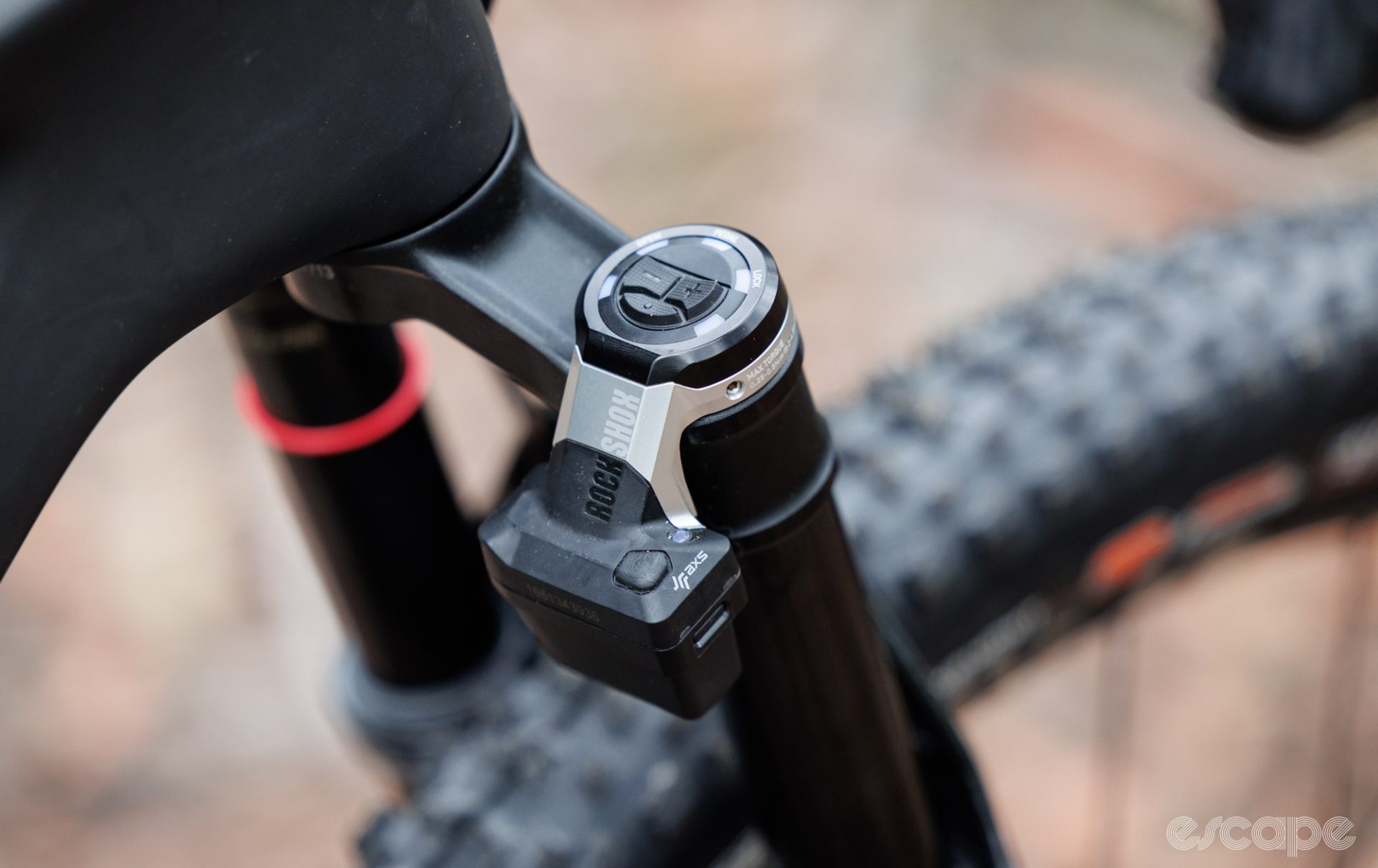
Speaking of the batteries, I question why SRAM doesn’t offer a smaller capacity option for the weight weenies who merely want a race-worth of juice. Sure, not much weight would be saved from the current 28g battery, but given there are four of these batteries on my test bike, there is an opportunity to save a smidge of weight and get a more svelte aesthetic. I know this is a niche request, but SRAM seems to think choice is good in so many facets of its product range, so it bothers me only to have one option here.
Flight Attendant does mean you’re adding at least another two to keep track of. The SRAM AXS app is a huge help here, but this system is absolutely not for those already bothered by having to charge a derailleur battery. It’s a set-and-forget suspension system, but only as long as you remember not to forget to do the occasional charging.
There’s also the noise of the actuator motors to contend with. Riding alone reveals an ongoing zzztt-zzzttt as the suspension does its thing, and given the fork is in front of you, it’s far more obnoxious than the noise of an AXS rear derailleur. I liked knowing when the suspension was changing, but outside of racing, I could see this getting a little annoying to listen to.

And not to get too yelly-at-the-clouds, but it’s worth noting that Flight Attendant introduces even further proprietary technology with limited repairability options for the damper. Already, the damper inside the SID fork is considered more of a throw-away than a rebuildable item, and you can bet any electrical issues will be treated in a similar way. For some, the performance benefit will be easily worth the trade-off here, while for those bothered by it, you may be better served by Fox’s more serviceable product range. Still, this suspension is otherwise serviced like any other, and the lack of lockout cables make it vastly easier to take it off and put it on the bike.
Minor nuisances aside, this stuff is extremely impressive and I truly believe the minor weight gain is easily offset by the ability to focus on all other facets of trying to go fast. It’s also exciting to think that it’ll only improve as RockShox collects more data and refines its firmware. I’d also love to see RockShox update its AXS dropper to be positionally aware, as I think being able to drop the seatpost and therefore force the suspension to open would be hugely beneficial.
Not a gimmick, this is where XC is headed
There’s little denying that electronically controlled suspension has reached a maturity point where it’s here to stay. And SRAM’s Flight Attendant is the most dialled, integrated, and user-friendly version I’ve witnessed so far. When combined with SRAM’s app and other AXS components, such as an Eagle Transmission, it truly is an impressively simple system to live with.
Most importantly, it does a task with less compromise (ignoring price) than any other option. Cable-controlled systems may still be lighter and, in a sense, simpler—at least when they work. But I truly despise constantly telling my suspension when I want to pedal, especially when I already have my dropper post and shifting, stealing my focus from the trail and my burning lungs.
Such a benefit strongly makes me believe that we’re witnessing the future of cross-country race technology. Yes, it’s currently only for those who get their stuff for free or who don’t shop based on price, but there is a real benefit for these lucky few.
It’s so good that my mind is buzzing, wondering how this may impact future suspension frame designs. If any frame design can be made to automatically pedal so well, will we see an increase in brands running more sag, less anti-squat, and generally more reactive designs? This is a big question, but I also can’t help but think that we’re already there with the number of bikes using and needing cable-operated lockouts to pedal well under high power. For these bikes, Flight Attendant is a superior answer. Similarly, I can see why Specialized has discontinued its Brain technology, as after all, Flight Attendant has it beat in just about every metric.
Similarly, my decade-old dream of having your suspension electronically controlled based on GPS position on a race course is, in theory, closer than ever. Whether this would offer any benefit over the new Adaptive Ride Dynamics is the big question, but it would be a neat feature for those racing at the top end of the sport on a lap-based course, where you could pre-program exactly where and when the suspension does its thing.
More often than not the suspension was just doing its thing, and I was doing mine. I quickly learned to trust it on descents, when pre-loading for jumps, or pedalling into a rock garden. It also encouraged me to ride more aggressively than I would typically do, whereas with other bikes, I may choose to sit and spin rather than flick the suspension, Flight Attendant had me smashing the pedals in as much excitement as my fitness would allow while knowing that seconds later I’d need my hand on the dropper post remote. It’s not 100% perfect, but it is damn good for the majority of terrain, and would be exactly what I’d want in building my dream cross-country race bike.
What did you think of this story?
